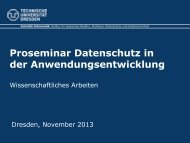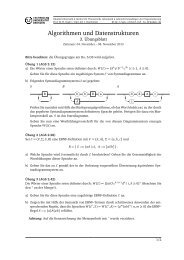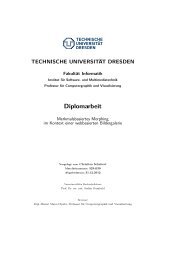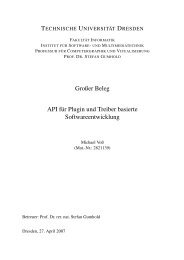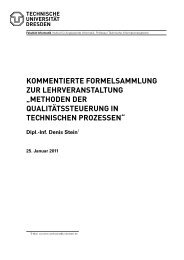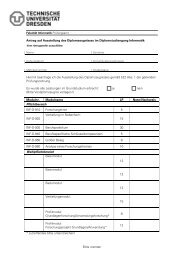Kryptographie und Kryptoanalyse
Kryptographie und Kryptoanalyse
Kryptographie und Kryptoanalyse
Sie wollen auch ein ePaper? Erhöhen Sie die Reichweite Ihrer Titel.
YUMPU macht aus Druck-PDFs automatisch weboptimierte ePaper, die Google liebt.
4 Symmetrische Verfahren – Kryptographische Güte<br />
Beispiel (S Bsp)<br />
m<br />
m2 1 000 001 010 011 100 101 110 111 <br />
000 2 2 2 6<br />
001 2 1 1 4<br />
010 2 1 1 4<br />
011 1 1 2 4<br />
100 2 1 1 4<br />
101 1 1 2 4<br />
110 1 1 2 4<br />
111 2 2 2 6<br />
Gesamtzahl der geänderten Bits 36<br />
<strong>Kryptographie</strong> <strong>und</strong> <strong>Kryptoanalyse</strong><br />
4 Symmetrische Verfahren – Kryptographische Güte<br />
Linearität<br />
Eine Funktion f: {0,1} n {0,1} m ist dann linear, wenn jedes<br />
Output-Bit y i linear von den Input-Bits x i abhängt:<br />
y i = a j,1 x 1 + a j,2 x 2 + … + a j,n x n + b j<br />
Wenn wenigstens ein Output Output-Bit Bit linear von den Input Input-Bits Bits<br />
abhängt, ist f partiell linear.<br />
weiteres Maß: Grad der Übereinstimmung von f mit ihrer<br />
besten linearen Approximation g<br />
Güte der Approximation: Anteil der Funktionswerte, in denen<br />
f <strong>und</strong> g übereinstimmen<br />
<strong>Kryptographie</strong> <strong>und</strong> <strong>Kryptoanalyse</strong><br />
4 Symmetrische Verfahren – Kryptographische Güte<br />
Korrelationsimmunität<br />
f(x1, x2, …, xn) boolesche Funktion in n Variablen<br />
Die Funktion f heißt dann k-korrelationsimmun, wenn man<br />
aus Kenntnis von k beliebigen Eingangswerten keine<br />
Information über den resultierenden Ausgangswert erhalten<br />
kann <strong>und</strong> umgekehrt.<br />
<strong>Kryptographie</strong> <strong>und</strong> <strong>Kryptoanalyse</strong><br />
109<br />
110<br />
111<br />
37



